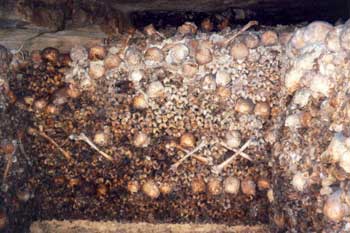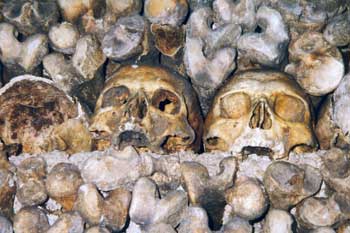

|
3. PARIS - The Catacombs is full of bones
The different phases of expansion of Paris have always required the use of local quarries. At the beginning, in the Roman time, it was open-sky quarries. At the end of the tenth century the first underground quarries were excavated. Since the 12th and 13th centuries the quarrying has taken on a more industrial scale, notably for large construction projects, such as ramparts to protect the city, Notre-Dame cathedral, the royal fortress of the Louvre and other buildings.
Many quarries created in the subsoil were forgotten over time; and only a few cavities were filled to avoid accidents. Finally after a series of collapses authorities responded to the danger. On April 4, 1777 the Inspection Générale des Carrières was created to list and to reinforce the quarries of Paris.
Completely different from the catacombs of Rome that served as a refuge for the first persecuted Christians, the "catacombs" of Paris are only about two hundred years old. Old underground galleries and quarries were transformed, for reasons of public health, into a gigantic "Ossuaire général des cimetières de Paris".
By the eighteenth century, the odours and threats of pestilence from the cemetery of the Innocents disturbed the surrounding neighborhood. This cemetery in the middle of Paris had received the remains of thirty generations of people who died in the twenty parishes of the city.
Decomposition generated some murderous epidemics. The cemetery was so overcrowded that its soil was more than eight feet over the level of the street. In 1780 some Parisiens were asphyxiated in the cellars near the mass grave.
Because of the unceasing neighboring district complaints, a decision was made in 1785 to transfer the bones to the quarries of "Mont-Rouge", which at that time was outside of Paris. On April 7, 1786, the curate of the archbishop of Paris proceeded to the consecration of the "catacombs".
At twilight funeral wagons covered with black sheets began the transfer of bones, followed by priests who sang the service of deaths. In the smoky gleam of torches, sacks were emptied and remains were poured without care in the subsoil of the "Mont-Souris" plain. Day after day it continued, the transfer lasted fifteen months.
During the next 115 years, some thirty other Parisian cemeteries and mass graves were closed and had their remains moved.
The "catacombs" one can visit today represent only an eight-hundredth of all the quarries under Paris.
W fearlessly led our way, first down a winding stairway, and then through a tight passageway for several blocks beneath the surface streets, until we finally reached the storage areas. Many gasps were drawn from the other visitors. After Versailles where he kept muttering "One guy," D was quiet and then said only, "So many!" W agreed, "This is more like it!"
|